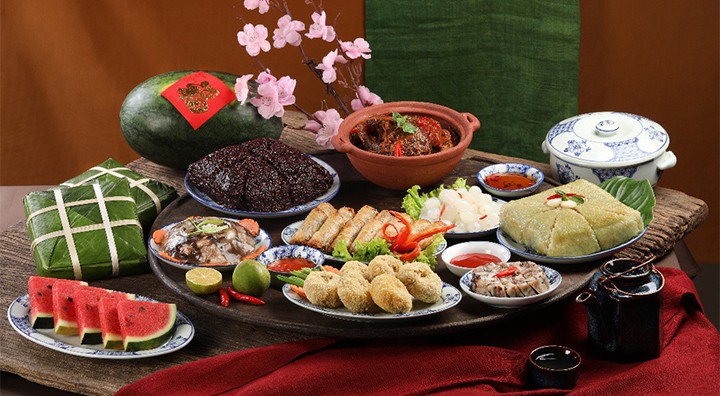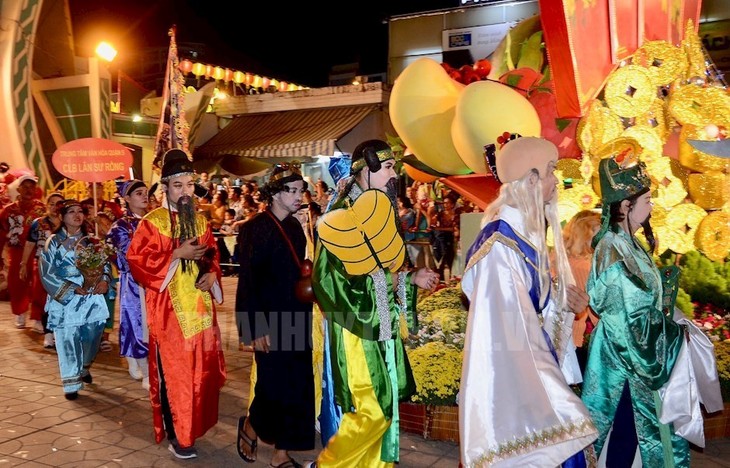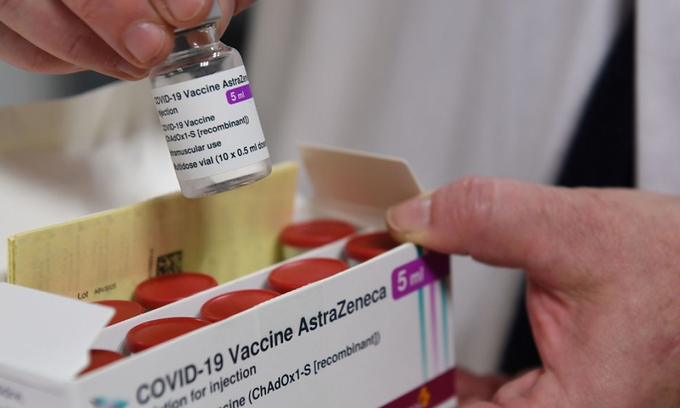B: The New Year atmosphere is still around us as we continue to receive Lunar New Year greetings from our listeners around the world.
A: Actually, the New Year celebration in Vietnam is not over until we celebrate the first full moon of the new year. Tet Nguyen Tieu - or the First Full Moon of the New Year - falls on February 26th this year, and is a major Buddhist festival in Vietnam. It’s also a fantastic opportunity for foreigners to experience Vietnamese culture.
 Food prepared to worship in the First Full Moon ceremony Food prepared to worship in the First Full Moon ceremony |
B: Most Vietnamese people believe that the First Full Moon of the New Year is the most important of all full moons throughout the year. On the 15th day of the first month of the Lunar Calendar, people are supposed to go to pagodas and pray for good fortune for their family and close friends. It is not uncommon to see people consuming vegan food and drinking water on this auspicious day. A peaceful mind and good luck for the coming year are the key themes of this festival.
A: Chinese descendants in District 5 of Ho Chi Minh city celebrate the festival from the tenth day until the end of the first lunar month.
 Chinese descendants in District 5 of Ho Chi Minh city celebrate the festival from the tenth day until the end of the first lunar month (Photo: thanhuytphcm.vn) Chinese descendants in District 5 of Ho Chi Minh city celebrate the festival from the tenth day until the end of the first lunar month (Photo: thanhuytphcm.vn) |
B: The highlights of the celebration include parades and street performances from the 12th to 18th day of the lunar month. The festive event also features various other activities such as performances of traditional Chinese opera, lion dancing, martial arts, mandala making, calligraphy, and street art.
A: Vegan food is also commonly enjoyed, as it is believed to purify soul. Cho Lon, in District 5 of Ho Chi Minh City, is the most exciting place to visit during Tet Nguyen Tieu. You may try che troi nuoc, a special sweet yoghurt dessert with jellied balls made from sticky rice and sugar syrup , which symbolizes “Reunion”. The Cultural Center of District 5 is often the place where most activities to celebrate Tet Nguyen Tieu take place.
B: Similar to Ho Chi Minh City, if you are in Hue and Danang during this occasion, you will see a grand, though a lot calmer, celebration of Tet Nguyen Tieu. Vegetarianism is widely practiced.
A: In the north, Tet Nguyen Tieu is more about praying to the ancestors. People will be busy shopping for groceries and paper offerings, as well as flowers and fruits to put up on the family altar.
B: The Vietnamese Ministry of Culture, Sports and Tourism has recognized the First Full Moon Festival as an event of national, intangible cultural heritage.
A: This week, many listeners asked us about the state of the COVID-19 pandemic in Vietnam. Commenting on our stories about Vietnam’s efforts to contain COVID-19, Frank Meyers, a retired US public health advisor said he would like to know the current number of infections in Vietnam rather than the number of new cases so he can assess the actual risk.
B: In our stories, we often mention the number of new cases to see if current transmission of the virus is high in the community or under control. The total number of infections is also included in our reports.
 (photo: nhandan.com.vn) (photo: nhandan.com.vn) |
A: As of Wednesday morning, there have been 1,504 community infections so far, of which 811 were part of the COVID-19 resurgence since January 27. The total number of infections seen in Vietnam since the epidemic began last year is 2,403. Total recoveries have numbered 1,760 and the death toll remains at 35.
B: More than 88,000 people who have had close contact with COVID-19 patients or who arrived from pandemic-hit areas are currently in quarantine.
A: Localities nationwide are strengthening their disease prevention measures. Hai Phong city has raised COVID-19 prevention and control to a higher level after recording new COVID-19 infections.
B: Students in neighboring Quang Ninh province will return to school on March 1, but COVID-19 prevention and control measures will be tightened. Local COVID-19 checkpoints will be removed but Quang Ninh will closely control people and vehicles entering the province. Travelers from COVID hotspots will not be admitted.
A: Hanoi will step up testing, quarantining, and punishing people who violate COVID-19 regulations. Hanoi has recorded no new domestic transmissions within the past week and says schools and festivals will resume if this trend continues.
B: In HCM City, medical workers test customers and workers at restaurants for the coronavirus.
A: In the past week the HCM City Center for Disease Control has conducted 4,800 random tests at airports, bus stations and train stations. So far 3,800 tests have proven negative and the remaining results are still awaited.
B: HCMC suspended all non-essential services on February 9 shutting down bars, karaoke clubs, cinemas, discotheques, and religious events.
A: Since January 28, when community transmission returned to Vietnam after almost two months, HCMC has found 36 new cases in eight districts. 35 were linked to an outbreak at Tan Son Nhat airport, whose origin has yet to be identified, and the other case to Hai Duong, the country’s epicenter.
B: The latest wave, which began in Hai Duong and Quang Ninh province, has spread to 13 other cities and provinces. HCMC has detected no new cases in the last 12 days.
A: Meanwhile, the first batch of more than 110,000 doses of Oxford/AstraZeneca's COVID-19 vaccine arrived at Tan Son Nhat Airport on Wednesday morning.
B: Health care workers and others involved in fighting COVID-19, diplomats, and customs and immigration officers are among the priority groups in Vietnam’s vaccination plan.
A: The Ministry of Health has set forth a plan on the acquisition, preservation, distribution, and use of COVID-19 vaccines until 2022, with the support of the COVAX Facility - the global initiative to ensure rapid and equitable access to COVID-19 vaccines for all countries.
B: Other groups included in the vaccination plan are the armed forces, teachers, people over 65, people who provide essential goods, people with chronic diseases, people who work or study abroad, and residents of pandemic-hit areas.
A: The vaccination will be implemented nationwide, from high risk to low risk areas. Vietnam expects to have 80% of its population vaccinated against COVID-19. However, the current supply will allow only 20% of the population to be vaccinated this year
B: This week, we’d like to welcome back Deep Paul of India. Deep Paul sent us a reception report for a program on February 3rd from 16:01 to 16:30 UTC on the frequency of 7220 khz.
B: We’d like to confirm a reception report from Siddhartha Bhattacharjee of India, who listened to our program on Feb 21st from 1600 to 1630 UTC on the frequency of 7220 khz and rated SINPO between 3 and 4.
A: Thank you very much for sending feedback on our broadcasts. Beginning March 28th, listeners who now tune to 7280 khz should switch to 11885 khz to hear VOV. We will keep reminding you of the frequency change between now and March 28th. We hope the change will bring you better reception quality.
A: We always welcome your feedback at: English Service, VOVworld, the Voice of Vietnam, 45 Ba Trieu street, Hanoi, Vietnam. Or you can email us at: englishsection@vov.vn. You’re invited to visit us online at vovworld.vn, where you can hear both live and recorded programs.
B: Check out our VOV Media App, available on both the IOS and Android platform, to hear our live broadcasts. We look forward to your feedback on the mobile version of vovworld.vn. Once again, thank you all for listening. Goodbye until next time.